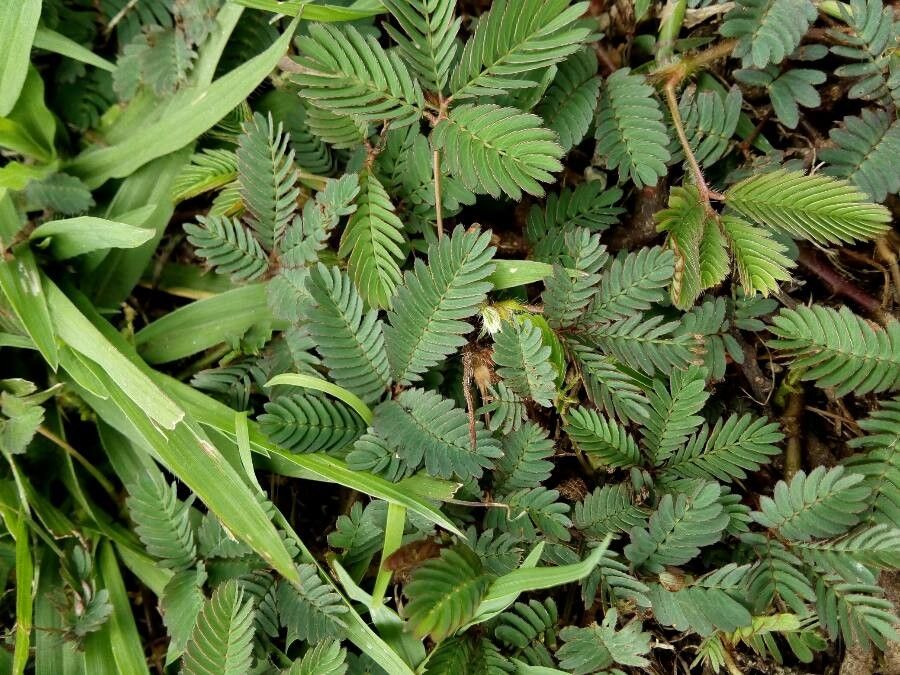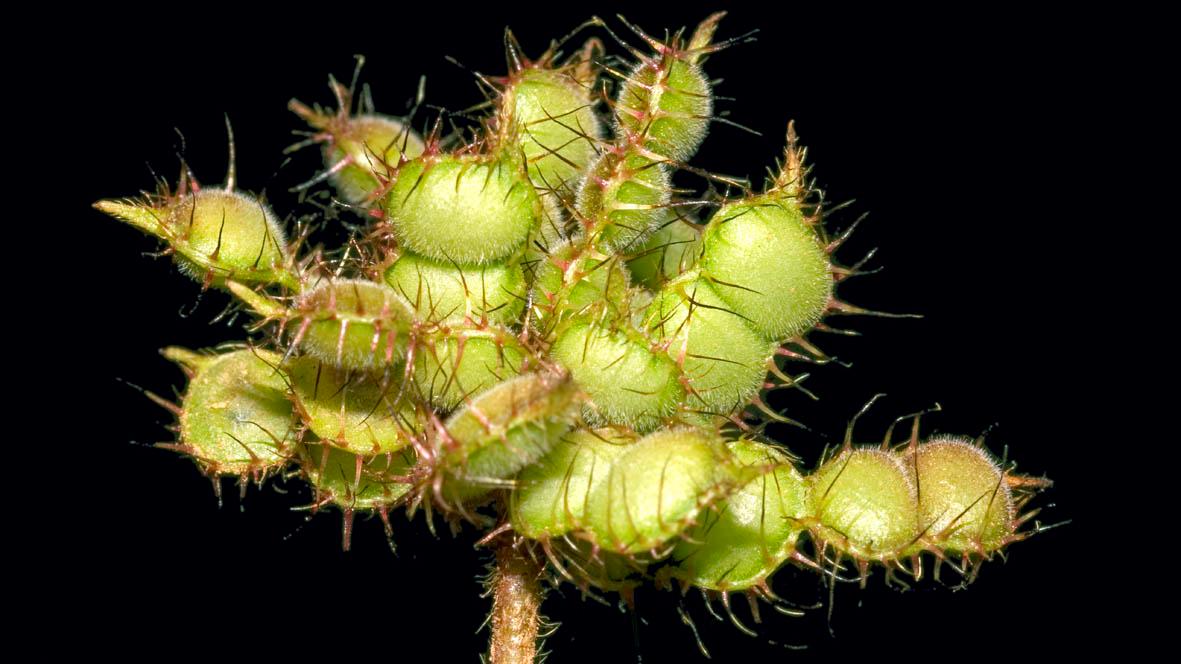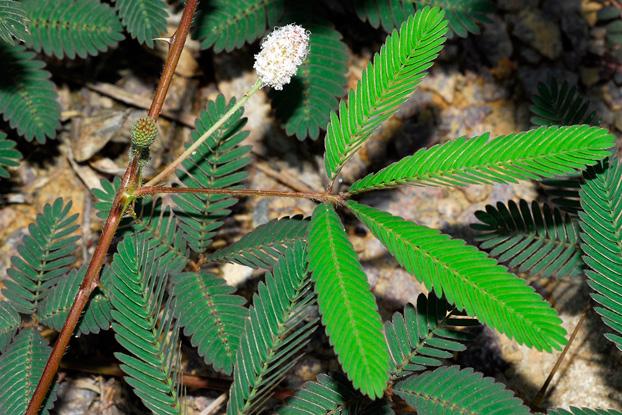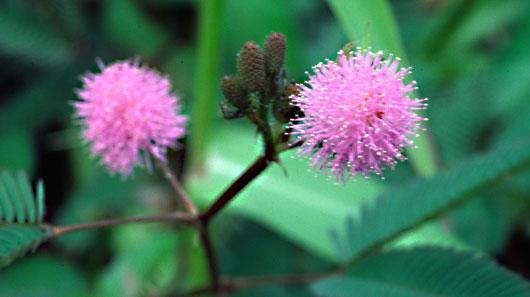Sensitive Plant
mimosa pudica
Also known as: ["Touch-me-not","Humble Plant","Shy Plant"]
Overview
A small, creeping or semi-erect annual or perennial herb known for its rapid leaf movement when touched.
Benefits & Perks
["aesthetic foliage","wildlife attractant (bees, butterflies, birds)"]
Botanical Classification
| Phylum: | Magnoliophyta |
| Class: | Magnoliopsida |
| Order: | Fabales |
| Family: | Fabaceae |
| Genus: | Mimosa |
| Botanical Name: | Mimosa pudica |
Plant Characteristics
Basic Information
- Category: Herbs & Weeds
- Suitable Location: indoor pot in a warm, humid room with bright, indirect light
- Suitable For:
- Is Weed: No
- Allergenicity: low
Environmental Needs
- Climate: {"temperatureRange":"20–30°C, intolerant of frost"}
- Hardiness: {"zones":"10–12"}
- Misting: every 2–3 days to maintain high humidity, especially in dry environments
- Drainage: Fast-draining to prevent waterlogging.
- Soil Type: Well-draining potting mix with added perlite or sand for aeration.
Maintenance Level
- Maintenance Level: moderate
- Toughness Level: moderate
- Pruning Frequency: As needed, or every 2–3 months to keep the plant compact.
- Pruning Intensity: Light to moderate; avoid heavy pruning which can stress the plant.
Care Details
Ideal Sunlight Coverage:
Bright indirect light for 6–8 hours daily; tolerate partial shade but avoid direct sun which can scorch leaves.
Sunlight Tolerance Tips:
Acclimate gradually to brighter light; protect from intense midday sun; indoors, place near an east or north window.
Care Requirements
Care Difficulty
easyeasy
Sunlight
partial shade to filtered sunlight
Rotate plant for even light exposure; use sheer curtains to filter direct sun; adjust light levels seasonally.
Watering
every 5–7 days, allowing soil to dry slightly between waterings
Keep soil consistently moist but not waterlogged; avoid letting the plant sit in water; ensure good drainage.
Soil
well-draining, slightly acidic potting mix with peat or compost
pH: Slightly acidic to neutral (pH 6.0–7.0).
Ensure pots have drainage holes; avoid heavy clay soils; check moisture before watering.
Temperature
Prefers warm conditions, 65–85°F (18–29°C); sensitive to cold below 50°F (10°C).
Avoid sudden temperature changes; maintain stable warmth; protect from drafts.
Fertilizing
every 2 weeks during active growth (spring and summer), with a balanced liquid fertilizer diluted to half strength
Dilute fertilizer to prevent burn; fertilize only when actively growing; flush soil occasionally to prevent salt buildup.
Propagation
Methods
Stem cuttings in water or moist soil.
Step-by-Step Propagation Guide
- Select healthy stem, cut below a node, remove lower leaves, place in medium, keep moist, wait for roots.
Best Time: Spring or early summer when the plant is actively growing.
Environment
Warm, humid environment with indirect light; maintain consistent moisture.
Medium
Well-draining soil mix or water with occasional nutrient additions.
Hormone
Optional but can speed up rooting; use a mild rooting hormone if desired.
Timeline
Roots typically form in 2–4 weeks; new growth may take 1–2 months.
Tools Needed
Sharp scissors, rooting hormone (optional), small pots or jars, well-draining medium.
Quick Tips
Use healthy, non-flowering stems; keep cuttings out of direct sun; maintain humidity around cuttings.
Pruning & Repotting
Pruning Guide
Method
Pinch back tips or snip stems just above a leaf node to encourage branching.
Pruning Plan
Light pruning to maintain shape and encourage bushier growth; remove dead or leggy stems.
Tools
Clean, sharp scissors or pruning shears.
Checklist
Sanitize tools, prune dead/leggy stems, shape as desired, avoid over-pruning.
Repotting Guide
Best Season
Spring, before the main growing season begins.
Pot Size
One size up (e.g., from 4-inch to 6-inch pot); ensure good drainage holes.
Method
Gently remove plant, trim any circling roots, place in a slightly larger pot with fresh well-draining soil, water lightly.
Suggestions
Repot annually or when roots fill the pot; mimosa pudica grows quickly and benefits from fresh soil.
Checklist
Check root bound status, prepare new pot, trim roots if needed, use fresh soil, water lightly after repotting.
Advanced Care Tips
Watering Mastery
Watering Checklist
Check soil moisture, water evenly, ensure drainage, adjust for season.
How to Apply Water Properly
Water thoroughly until it drains from the bottom, ensuring even moisture distribution without saturating the soil; water early in the day to allow foliage to dry.
Watering Schedule Tips
Water when the top inch of soil feels dry; reduce frequency in winter to prevent root rot.
Soil Improvement
Add perlite or coarse sand to improve drainage; incorporate organic matter like compost for fertility.
Temperature Stress Management
Signs of Temperature Issues
Wilting, leaf drop, slow growth, or leaf discoloration (yellowing or browning).
Cold Stress
Stagnant growth, leaf curling, and potential death if exposed to prolonged cold.
Solution: Move to a warmer location, insulate pots, avoid cold drafts, and protect from frost.
Hot Stress
Leaf wilting, drooping, or closure (due to heat-induced dormancy), reduced photosynthesis.
Solution: Provide shade, increase humidity, water more frequently, and ensure good air circulation.
Fertilizing Guide
Fertilizing Checklist
Check growth phase, dilute correctly, apply to soil, avoid foliage contact, stop in winter.
Fertilizing Method
Use a balanced liquid fertilizer diluted to half strength every 4–6 weeks during growing season (spring/summer); avoid fertilizing in winter.
Common Problems & Solutions
Toxicity Warning
Cats
Slightly ToxicCats may experience mild gastrointestinal upset if they ingest Mimosa pudica seeds or roots. The plant contains compounds that can irritate the digestive tract, leading to mild symptoms.
⚠️ Symptoms:
🌿 Toxic Parts:
⚡ Toxic If:
if eaten
Dogs
Slightly ToxicIn dogs, ingestion of Mimosa pudica seeds and roots can lead to mild gastrointestinal upset due to the presence of saponins and other irritants. The effects are generally not life-threatening but can cause discomfort.
⚠️ Symptoms:
🌿 Toxic Parts:
⚡ Toxic If:
if eaten
Humans
Slightly ToxicMimosa pudica contains compounds that can cause mild gastrointestinal distress when ingested. The seeds and roots are the most toxic parts, containing saponins and other irritants that may lead to mild physiological discomfort.
⚠️ Symptoms:
🌿 Toxic Parts:
⚡ Toxic If:
if eaten
Frequently Asked Questions
Q: Why do the leaves of Mimosa pudica close when touched?
A: The leaves exhibit thigmonasty, a rapid response to touch or vibration, likely as a defense mechanism against herbivores.
Q: Is Mimosa pudica toxic to pets?
A: It is mildly toxic to dogs and cats if ingested, causing mild gastrointestinal upset.
Q: How often should I water Mimosa pudica?
A: Keep the soil consistently moist but not waterlogged; allow the top inch of soil to dry between waterings.
Quick Reference
| Family: | Fabaceae |
| Care: | easy |
| Light: | partial shade to filtered sunl |
| Water: | every 5–7 days, allowing soi |
Get Expert Care Tips
Download the Plantious app for personalized care reminders and plant identification!
Google Play App Store








